|
IN BRIEF
|
In the ever-evolving landscape of law enforcement, community policing has emerged as a transformative approach, reshaping the relationship between the police and the communities they serve. Unlike traditional models that often prioritize crime control through authority and enforcement, community policing emphasizes collaboration, trust, and proactive engagement with residents. In Canada, this strategy represents a significant shift in policing ideology, focusing on the unique needs of communities and aiming for crime prevention through partnerships rather than mere reaction to incidents. By understanding the multifaceted tactics and objectives of community policing, we can appreciate its role in enhancing safety and fostering a sense of togetherness. This exploration serves as a gateway to examining how police forces across Canada are reimagining their methods to create a more secure and supportive environment for all citizens.

Community policing represents a significant shift in the way law enforcement interacts with the public. In Canada, it has become an integral part of policing operations, prioritizing community needs and fostering public trust. By moving away from traditional crime control paradigms, community policing emphasizes the importance of community involvement in maintaining public safety.
Final Thoughts on Community Policing in Canada
Community policing is fundamentally about understanding the needs of the community and forming trusting relationships. This approach fosters a shared sense of responsibility for public safety and encourages proactive measures to prevent crime. As law enforcement continues to adapt to the complexities of modern society, community policing strategies will remain at the forefront of progressive policing in Canada. The focus on collaboration and engagement will be instrumental in shaping the future of public safety for all communities.
Community Partnerships
Building strong partnerships is fundamental to community policing. By engaging with community members, police can better understand local needs and concerns. These partnerships include various stakeholders, such as schools, local businesses, and social service organizations, all working together to improve the quality of life in neighborhoods. Some initiatives may involve establishing neighborhood watch programs or facilitating community meetings to discuss safety concerns.

In recent years, community policing has emerged as a vital strategy within the Canadian justice system, emphasizing the importance of public trust and community engagement. Unlike traditional models that prioritize crime control, community policing focuses on the needs of the community, aiming to prevent crime through collaboration and partnership. Statistics reveal that communities actively involved in policing initiatives report a 20% decrease in crime rates compared to those that rely solely on conventional methods.
Moreover, the integration of community policing strategies demonstrates a shift in how police perceive their role. For instance, according to Public Safety Canada, effective community policing comprises two main components: community partnerships and problem-solving approaches. By working directly with community members, law enforcement can better address underlying issues that may contribute to criminal behavior.
Furthermore, in Ontario, the Mobilization & Engagement Model illustrates the comprehensive nature of community policing, showcasing a continuum of services designed to ensure public safety and well-being. This model not only fosters stronger relationships between police and residents but also enhances the overall effectiveness of law enforcement across the province. As such, the evolution towards community policing in Canada signifies a progressive response to evolving public safety needs. For an in-depth exploration of this strategy, refer to resources such as The Canadian Encyclopedia and Public Safety Canada.

Understanding community policing strategies in Canada reveals a significant shift in the approach to law enforcement. Community policing emphasizes the importance of building trust between police and residents, moving away from traditional methods focused solely on crime control. This strategy prioritizes the needs of the community and fosters partnerships aimed at promoting safety and well-being. By adopting a more holistic approach, police are empowered to address the root causes of crime through collaboration, problem-solving, and active participation from community members. Various policing models illustrate how this approach can enhance public safety and build resilience in neighborhoods. Ultimately, the effectiveness of community policing hinges on its adaptability and the commitment to responding to the unique challenges faced by each community.
FAQ
What is community policing in Canada?
R: Community policing in Canada is an approach that prioritizes the needs of the community and fosters public trust, moving away from traditional crime control methods. It emphasizes collaboration between police and local communities to enhance safety and well-being.
How does community policing differ from traditional policing?
R: Unlike traditional policing, which primarily focuses on crime control, community policing expands its goals to include proactive crime prevention and building relationships with community members. It emphasizes understanding community dynamics and addressing underlying social issues.
What are the main components of community policing?
R: The main components of community policing include community partnerships and problem-solving initiatives. This approach encourages police to engage with residents, build trust, and collaboratively identify and tackle local issues affecting safety.
How does community policing contribute to crime prevention?
R: Community policing helps prevent crime by fostering partnerships that allow the police to address issues before they escalate. By protecting vulnerable populations and targeting problem areas, this strategy effectively reduces criminal activity and enhances community safety.
What strategies are used in community policing?
R: Community policing employs a range of tactics, including community engagement initiatives, educational programs, and collaboration with local organizations. These strategies are designed to empower residents, promote safety, and create a sense of shared responsibility for maintaining public security.

